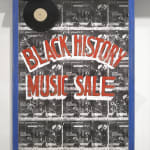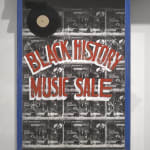


Jamal Cyrus
Further images
Begun in 2005, Jamal Cyrus's ongoing project Pride Records is a series of three record store installations charting the trajectory of the imagined label through the 1960s and 1970s. Two Pride Record installations exist-one a Los Angeles storefront and one a display of records in a Tokyo shop -and the artist is developing the third. The installations are full of subtle allusions and meticulously observed details; seen closely, the narrative of Pride's fall unfolds in the nuances. In each edition, Cyrus includes found albums, albums with some minor insertions or changes, and entirely fabricated albums. Within this combination, he is able to blur the boundaries of what is real and imagined in order to tell a fuller history.
Founded in Detroit in 1968, the label's earliest imprints were marked by a strong civil rights and Black pride agenda. With more than 300 independent record labels in Detroit during that decade, Pride was part of a flourishing scene, much of which has subsequently been forgotten. Among these early records are Sharhonda and the Black Stone Queens, which references the street gang Black Stone Rangers of Chicago. On the album cover, Sharhonda clings tightly to the autobiography of Malcolm X, which becomes a kind of life preserver as the water surrounds her. Other albums such as Uhuru Splatter: The Visions of African Mystics and It's Nation Time: African Visionary Music look to the mystic traditions of Africa as a source of knowledge and power. Dmfd: Three Tears for Fred and Dowling Street Martyr Brigade remember Black Panther activists killed by police: Fred Hampton, killed in 1969 in Chicago; and Carl Hampton, killed in 1970 on historic Dowling Street in Houston. Culled from Civil Rights Anthologies and spoken word recordings, Cyrus's albums also include a found Nikki Giovanni album which blended spoken poetry and music, and an altered O. G. Holliday album of sermons.
By the 1970s, under pressure from the FBI (which was infiltrating Black literary and musical circles with informants looking for Communist sympathizers), Pride shifted its catalog to include more disco records. This glossier, neutered version of Pride was both more politically safe and more economically viable for the label: the shift mirrors a broader cultural phenomenon from the cultural solidarity of Black Power in the 1960s to the emphasis on Black consumer power in the 1970s. Cyrus hints at the FBI investigations with his Runaways: Sub Terror cover, which has a redacted FBI file document overlaid upon the image. The Runaways appear twice on the display, in their Sub Terror album and, disco-fied, with Good, Bad & Funky. In the later album, the band is less political and more polished; indeed, even their graphic identity changes to match the corporate revision of their work. Similarly, Sharhonda reappears in a disco record alongside the BB playboys and costumed in a glowing white wide-legged jumpsuit. Finally, Little Bobby bookends the collection. In the first album--the first Pride record to be made--he appears with the Mau Mau's in a Do-op recording with a collage-like DIY cover. By the end of Pride, Little Bobby is bandless and hollow-eyed, the Secret Rendezvous perhaps alluding also to FBI informants and to backroom dealings at the label.
By imagining the life and expiration of Pride Records, Cyrus charts the visual identity of a potent political moment and cultural shift. His understanding of the power of the 60s and its fall takes popular culture as a mirror, a way of describing the ever-shifting layers of power, cultural identity, and political dreams.
Provenance
From the artist's studio
Exhibitions
Jamal Cyrus "The End of My Beginning", Blaffer Art Museum, University of Houston, Houston, TX June 5 – September 29, 2021; Institute of Contemporary Art, Los Angeles, February 5 – May 29, 2022; Mississippi Museum of Art, October 29, 2022 - March 5, 2023
"Spin: Turning Records Into Art", KMAC Museum, Louisville, KY, April 21 - August 5, 2018
"Sonic Rebellion: Music as Resistance", Museum of Contemporary Art Detroit, Detroit, MI, September 18, 2017 - January 7, 2018


